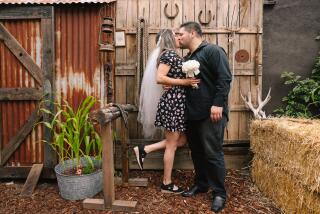Culture Pearls and Ethnic Accents Add Touches of Tradition to Happily Ever After
- Share via
The “something old” element in the familiar bridal equation amounts to far more than carrying Granny’s hankie or sixpence. Today’s brides are reaching into their roots to incorporate cultural and ethnic influences into their ceremonial garb.
A Chinese American bride may wear a red gown to signify love and joy. A Spanish American bride who wears a mantilla, a traditional handmade lace veil, enhances it with orange blossoms as a sign of fertility and happiness.
“Many American couples today want to personalize their wedding as much as possible,” explains Barbara Tober, editor in chief of Bride’s magazine. “More and more of these couples seek to bring all the significance of their past into their future together.”
Vietnamese American Kim Tang, who married in May, wanted a blend of old and new. She wore a traditional white gown for her Catholic ceremony but changed into an ao dai , a fitted dress with matching pants traditionally worn by Vietnamese brides, for photographs and the post-ceremony reception.
The pant component of the ao dai varies in length from just below the knees to ankle length. Bridal color choices include yellow (once reserved exclusively for Vietnamese royalty) and red. A fitted turban, a tradition hailing from the Chinese, is made in a color complementary to the bridal ensemble. White, worn by deceased individuals and their family members at funerals, is rarely selected by traditional Vietnamese brides.
Their grooms may wear an ao dai as well but only if the ceremony is very traditional. If the groom does select an ao dai, it’s usually dark blue, but red is also occasionally worn.
Tang’s husband, Danh Tran, opted for a Western-style suit.
An African American bride may wear a necklace of cowrie shells to convey beauty and power, or she may extend the look from head to toe. When Gina and Duane Williams married last summer, they wore white, light blue and gold striped ensembles made of Kente cloth, a brightly colored cotton fabric deeply rooted in African history and previously reserved for tribal kings. The Williamses’ entire wedding party wore home-sewn outfits in complementary African fabrics designed by the bride and crafted by her sister-in-law, Regina Williams.
Red is the choice of many brides in India. Vaneeta Varma, who was married in July, wore a red langa, a long skirt with a sari blouse and scarf. She says friends spent 30 minutes getting her into her langa and helping her with a red scarf that was pinned to her hair. She wore gold sandals on her feet.
“When I reached my 20s, I really began to appreciate my Indian background,” she says. “Wearing the langa was my way of not only honoring my ancestors, but doing something a little different, something traditional and trendy at the same time.”


